The Best Microphones for Recording Acoustic Guitar
As an Amazon Associate, I earn from qualifying purchases at no additional cost to you.

Whether you are looking to buy your first microphone for recording acoustic guitar, whether you are looking to upgrade your mic, or whether you are looking to pick up an additional microphone to provide you with a different sound on your tracks to make things more interesting, we have you covered.
We did extensive testing to determine the best mics for acoustic guitar and our top picks are below.
Certain microphones were tested in a stereo spaced pair. Other microphones were tested on their own. All microphones were positioned about 8 inches away from the acoustic guitar. Microphones which were tested on their own were miked at 12th fret, with tests run with the mic pointing at the 12th fret, and also towards the soundhole from the 12th fret area. Microphones that were tested in stereo had one mic aimed at the 12th fret and one aimed at the bridge.
Shure SM81
The top spot on our Best Microphones for Recording Acoustic Guitar list goes to the Shure SM81. The Shure SM81 is a small diaphragm, cardioid condenser microphone.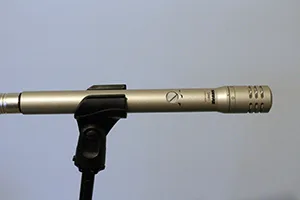 We tested the Shure SM81 in stereo as a spaced pair with one mic positioned at the 12th fret and the other at the bridge. The SM81, widely considered the best microphone for recording acoustic guitar, lived up to its billing.
We tested the Shure SM81 in stereo as a spaced pair with one mic positioned at the 12th fret and the other at the bridge. The SM81, widely considered the best microphone for recording acoustic guitar, lived up to its billing.
The SM81 produced a robust, full sound, which was warm and rich. It recorded a beautiful acoustic guitar tone which was smooth and lush, and at times shimmering. String noise was relatively minimal, though that is also affected by mic positioning.
It does pick up some breathing sounds if you are not careful while recording, but it’s much less noticeable than with large diaphragm condenser microphones.
In our testing, the Shure SM81, which was designed specifically to record acoustic guitar, was the clear cut top choice, and we recommend it highly. It is considered to be an “industry standard” microphone for recording acoustic guitars.
The Shure SM81 is also a good choice for cymbals, piano, and mandolin, and if you have a pair of SM81s, they are also a good choice for overhead drum mics.

Neumann KM184
The second spot on our Best Microphones for Recording Acoustic Guitar list goes to the Neumann KM184 small diaphragm condenser microphone. This mic, the successor to the legendary KM84, is one of the go to mics for recording acoustic guitar in the industry.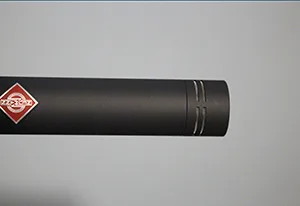 We tested a matched set of KM184s in a spaced pair. This mic, if you get 2 to do stereo recording, is the most expensive option on this list.
We tested a matched set of KM184s in a spaced pair. This mic, if you get 2 to do stereo recording, is the most expensive option on this list.
Strummed acoustic guitar chords recorded with the Neumann KM184 microphones sounded full, bright, well-rounded, and lively. It certainly captures a very robust guitar sound. The mics picked up the percussive attack of the guitar as well, in a good way.
On arpeggios, the Neumann KM184 mics produced a sparkling, bright, and rich sound which was quite pleasant to the ear.
For lead guitar type playing or single notes, the KM184 microphones produced a smooth sounding result. However, the string noise that was getting picked up was a little less than ideal.
For acoustic guitar fingerpicking, the Neumann KM184’s captured a warm, vibrant sound, and also picked up percussive sounds nicely.
Many people also use either one of these mics to record acoustic guitar or pair one KM184 with a different mic, often a large diaphragm condenser such as the Rode NT1 or the Neumann TLM 102. This second option is one way to reduce the string noise of the KM184 a bit if it is not your preference to hear that level of detail.
Overall, the Neumann KM184 delivered a smooth, vibrant sound that is somewhat on the bright side. It also captures excellent detail.
Neumann TLM 102
Our third pick on our Best Mics for Recording Acoustic Guitar list is the Neumann TLM 102. While this large diaphragm condenser mic is known more for its ability to record vocals, it performed very well in recording acoustic guitar.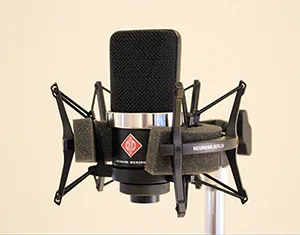 The Neumann TLM 102 captured a vibrant acoustic guitar sound that, like the Shure SM81, was rich, full, and warm. It recorded a very nice, pretty tone on individual notes, arpeggios, and chords.
The Neumann TLM 102 captured a vibrant acoustic guitar sound that, like the Shure SM81, was rich, full, and warm. It recorded a very nice, pretty tone on individual notes, arpeggios, and chords.
Like other large diaphragm condensers, it picks up lots of sound, so the guitarist needs to be careful of their breathing, especially if there are rests between guitar chords or notes.
While this mic was tested at the acoustic guitar’s 12th fret, both aimed at the twelve fret, and in a separate recording, aimed at the soundhole, it could also be paired with a different mic as part of a stereo set up.
In addition to shining on vocals, the Neumann TLM 102 can also be used to record electric guitar or, if you have a pair, it is a good choice for drum overheads.

Rode NT4
The fourth selection for our Best Microphones for Recording Acoustic Guitar list is the Rode NT4 X/Y stereo condenser microphone. Buying one Rode NT4 mic would allow you to achieve a stereo sound more affordably than if you were to buy 2 Shure SM81s or 2 Neumann KM184s. Additionally, the NT4 is nice because it is automatically in phase.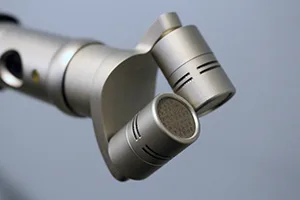 For strummed acoustic guitar chords, the Rode NT4 mic had a well-rounded sound that was somewhat darker and less dominated by the high end than, for example, the Neumann KM184. It does provide some shimmer on the top end but its sound is perhaps a bit more pronounced in the mid and low range overall.
For strummed acoustic guitar chords, the Rode NT4 mic had a well-rounded sound that was somewhat darker and less dominated by the high end than, for example, the Neumann KM184. It does provide some shimmer on the top end but its sound is perhaps a bit more pronounced in the mid and low range overall.
In terms of acoustic guitar arpeggios, the Rode NT4, with its somewhat darker sound produced a bit less luster and sparkle than some of the other mics. However, it produces a very natural sound that is largely uncolored in any way. Some people may strongly prefer it. A strong positive is that it picks up minimal string noise.
For lead guitar / single notes, the NT4 had a very nice tone that sounded especially good on vibrato. Once again, there was minimal string noise.
For acoustic guitar fingerpicking, the Neumann KM184’s captured a warm, vibrant sound, and also picked up any percussive sounds nicely.
The fingerpicked sound captured by the Rode NT4 was very warm and mellow sounding. Its relaxed sound was pleasant to the ear.
Overall, the Rode NT4 serves up a somewhat different sound than some of the brighter sounding microphones on this list. As alluded to earlier, some people may strongly prefer this more neutral, natural, and uncolored sound when they hear it. We liked it best on strumming and arpeggios and least for lead guitar and single notes.
Rode NT1
Our 3rd pick for our Best Mics for Recording Acoustic Guitar list is the Rode NT1. Another large diaphragm condenser mic that excels at vocals, the Rode NT1 does a better than good job at recording acoustic guitar with a pleasant and full sound.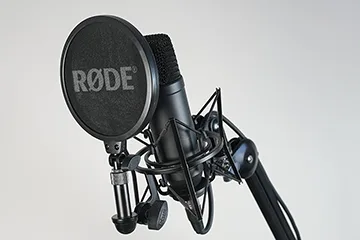 Considerably cheaper than the TLM 102 mic, the Rode NT1 only trails it by a notch in its performance recording acoustic guitar.
Considerably cheaper than the TLM 102 mic, the Rode NT1 only trails it by a notch in its performance recording acoustic guitar.
The NT1 performed slightly better on single notes (a very pretty tone) and arpeggios than it did on strumming, but both were good. It is a sensitive mic and definitely picks up a fair amount of the acoustic guitar’s percussive sounds while strumming, and whether that is good or bad depends on whether you want them in your recording or not.
Whereas this mic picks up a lot of sound, and may have even picked up slightly more unwanted sound than the TLM 102, guitarists should once again be aware of their breathing while recording.
In our acoustic guitar testing, the Rode NT1 captured good detail and a pretty sound on fingerpicking.

Shure SM57
The most affordable option on this Best Microphones for Recording Acoustic Guitar list is the iconic and excellent all around mic the Shure SM57 dynamic microphone. While we ran the tests for the Shure SM57 using 2 of them in a spaced pair set up, we previously recorded acoustic guitar for years using just one SM57. As with the Shure SM81, the set up here was one mic placed at the guitar’s 12th fret and the other aimed at the bridge. The distance was 8 inches or so. The combined tone of the 2 mics was well rounded, vibrant, and pleasant sounding, both for individual notes / argeggios and for strummed chords.
The combined tone of the 2 mics was well rounded, vibrant, and pleasant sounding, both for individual notes / argeggios and for strummed chords.
One note, however: when isolated, the 12th fret mic sounded a little higher and thinner than would be ideal, so we would suggest that if using one SM57 mic to record acoustic guitar, you may want to place it elsewhere, or, if at the 12th fret, aim it at the sound hole. If using two mics, as we did, the blended sound between the two was very good.
An additional thing to consider with the SM57, which is the only dynamic microphone on this list, is that as you increase the number of inches away that the Shure SM57s are positioned from the acoustic guitar, you can start to run into issues with not enough gain.
We ran these tests without using Cloudlifter CL-1s or another type of mic activator, but at 8 inches the mic distance was close to the point where using mic activators would have been helpful or even necessary. If you go farther out, like 10 or 12 inches from the acoustic guitar, you might need to think about using the additional clean gain that mic activators can provide in order to get the best results.

